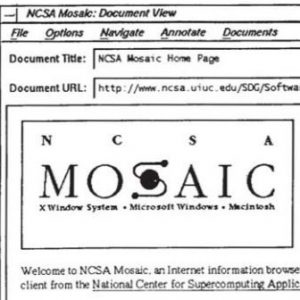You are reading this using the internet.
How did you find this page?
Perhaps you knew the specific Universal Resource Locator (URL). Maybe you knew the URL for the Illinois Distributed Museum’s (IDM) home page, and then clicked through a couple of hyperlinks to find this page. However you found this page, one thing is certain: your journey was fueled by some powerful Graphical Web Browser. This is the living legacy of the Mosaic Web Browser, an early internet navigator whose popularity introduced a generation of users to the wonders of a global information network.
In 1993, NCSA student programmer Marc Andreesen partnered with Eric Bina and others to bring a vision for a people’s internet to life. Mosaic built upon recent computing developments, including Xerox’s Graphical User Interface and Berners-Lee’s World Wide Web, to create a browser that a wide audience would learn to use and help to develop.
Mosaic was released on January 23rd, 1993. Silicon Valley investor Jim Clark persuaded Andreesen and a handful of other NCSA programmers to move to California and turn their idea into a business. Netscape Communications Corporation’s initial public offering (IPO) on August 9th, 1995 marked the beginning of the dot-com era. The company’s main offering was the Netscape Navigator, a commercial adaptation of Mosaic.
A few key features that drove Mosaic’s popularity:
Color and in-line pictures: Other browsers failed to see the value in delivering an aesthetically pleasing experience online. Even though earlier iterations of Mosaic didn’t load pictures well, Andreessen built in capabilities to create beautiful web pages that rivaled print magazines. Pictures were also in-line with text, instead of having to be opened in a new window like earlier browsers.
User responsiveness: Andreessen’s team iterated new versions of their browser early and often in direct response to user feedback
Back and forth buttons: This functionality gave users ability to view web pages they have recently visited.
Use of hypertext documents to make browsing an exploratory activity: How many times have you asked yourself while browsing the internet: “How did I get here?” Mosaic standardized the use of hyperlink navigation so that more than learn, users could discover what they didn’t know that they didn’t know, by using the internet.
The Netscape Corporation was bought by AOL in 1998. AOL stopped developing and releasing new versions of Netscape in 2008. While other browsers may have lasted longer, Mosaic, and then Netscape were important milestones in making internet browsers more user friendly and visually appealing.
National Center for Supercomputing Applications. Historical Marker located at the south entrance.
Andreessen, M.; Bina, E. (1994). NCSA Mosaic: A Global Hypermedia System. Internet Research, 4(1), 7 – 17. Retrieved from http://www.jstor.org/stable/2884507
Arrington, M. (2007). A Sad Milestoone: AOL to Discontinue Netscape Browser Development. Retrieved from https://techcrunch.com/2007/12/28/a-sad-milestone-aol-to-discontinue-netscape-browser-development/
Markoff, J. (1993, December 8). A Free and Simple Computer Link. New York Times. Retrieved from https://cs.illinois.edu/sites/default/files/images/In%20text%20-%20A%20Free%20and%20Simple%20Computer%20Link%20-%20NYT%20-%20December%208%201993_Page_1_smallest.jpg.
McCullough, B. (2018). How the Internet Happened: From Netscape to the iPhone. New York: Liveright Publishing Corporation.
Wolfe, G. (1994, October 1). The (Second Phase of the) Revolution Has Begun. Wired. Retrieved from https://www.wired.com/1994/10/mosaic/.

